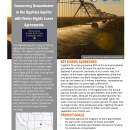Location



















States
New MexicoIntroduction
The Ogallala Aquifer underlies eight states, from South Dakota to Texas, providing 30% of the United States’ total irrigation water, and supporting 20% of the country’s agriculture harvest (Kite and Hardy, 2024). The region’s agriculture-based economy requires widespread irrigation, which is depleting the Ogallala Aquifer faster than the recharge rate (Dobrowolski, 2020). Clovis, New Mexico is entirely dependent on the Ogallala Aquifer to meet the water demand for municipal use and irrigation farming.
In response, the Ogallala Land & Water Conservancy (OLWC) and Cannon Air Force Base (CAFB) are entering three-year water rights lease agreements with landowners to conserve the aquifer’s remaining groundwater for critical municipal and CAFB use. The lease agreements annually pay farmers to stop irrigating their crops, thereby ceasing groundwater withdrawal. By reducing irrigation, project leaders hope to conserve the remaining groundwater in a paleochannel of the Ogallala Aquifer, located 1.5 miles north and northwest of CAFB. To ensure land that is no longer irrigated still provides valuable habitat and water-holding potential, CAFB and the OLWC are working with Playa Lakes Joint Venture (PLJV) and the Natural Resources Conservation Service (NRCS) to restore playa lakes and native grasslands for groundwater recharge.
The lease agreements are funded, in part, by the Department of Defense’s (DOD) Readiness and Environmental Protection Integration (REPI) Program and coordinated by OLWC. REPI provides funding to preserve environmental assets near military bases and increase resilience to climate change climate change
Climate change includes both global warming driven by human-induced emissions of greenhouse gases and the resulting large-scale shifts in weather patterns. Though there have been previous periods of climatic change, since the mid-20th century humans have had an unprecedented impact on Earth's climate system and caused change on a global scale.
Learn more about climate change (Veedmont, 2024). As a conservancy, the OLWC is also eligible to receive additional grant funding for the lease agreements and fund other water conservation efforts.
Key Issues Addressed
Irrigation for crops, including wheat and alfalfa, consumes 95% of the available groundwater in Curry County. If water consumption continues at its current rate, the county has at most 50 years before the groundwater is completely depleted. The project area is approximately 21,000 acres of land that overlie a paleochannel, an antiquated river containing pockets of groundwater, which supplies all irrigation water for the landowners in the project area. The recharge rate of the aquifer is a few tenths of an inch per year, and it will take 6,000 years to refill if fully depleted (Rawling and Rinehart, 2018, Plumer, 2012). Conserving water within the paleochannel is more feasible than transporting and filtering surface water because it is more affordable, conservation can start immediately, and the water is uncontaminated.
The creation of the groundwater rights lease agreements is the first time groundwater has been recognized as real property that can be leased by a land trust and military installation, necessitating direct negotiation to prove legal justification. Because the project is funded by REPI, the Air Force Civil Engineer Center (AFCEC) of the DOD had to approve the groundwater rights lease agreements. AFCEC attorneys were uncertain of how groundwater could be leased because leasing, versus purchasing, water rights was not recognized as the acquisition of real property.
Fair compensation to landowners entering the three-year water rights agreement includes both a cost for the groundwater at each well, as well as the profits lost from crop yields for irrigated acres. The funding required to compensate producers can be tens of millions of dollars, depending on how many landowners participate. Further, the groundwater quantity in the paleochannel area has decreased substantially since landowners initially acquired water rights. The groundwater at each property must be accurately measured to avoid lease agreement payments for water that no longer exists.
Once landowners stop irrigation, land has the potential to convert to fallow land with weedy vegetation and infertile soil. Active management is needed to ensure the landscape retains ecological function, such as wildlife habitat and soil water retention, amidst pressing conditions such as development and drought.
Project Goals
- Decrease agricultural irrigation to bank the remaining groundwater in a paleochannel of the Ogallala Aquifer for the City of Clovis, Curry County, and CAFB use in times of extreme drought.
- Through negotiation, demonstrate to the DOD and Air Force Civil Engineer Center the legal justification to treat groundwater as property that can be leased, and create the template for groundwater lease agreements.
- Accurately calculate and secure funding for landowner compensation.
- Transform irrigated farmland into dryland farms or grasslands for habitat restoration and restore playa lakes to increase groundwater recharge.
Project Highlights
Building Relationships with Trust: The success of the innovative groundwater conservation project is built on the foundation of relationships and mutual trust with local landowners who are OLWC priority partners.
- Paper Versus Wet Water: In 2022, project managers metered 53 wells in the first priority area of the paleochannel. Since the amount of water remaining was 57% less than the appropriated water rights, managers appraised revised water rights. Referred to as “wet water,” only the groundwater available was included in the water rights lease agreements. Out of the 13 landowners first contacted, 8 entered into the lease agreements.
- Incentivizing Landowner Participation: Managers calculated individual three-year crop budgets to ensure each landowner received the best price for the groundwater in their lease agreement. An appraiser considered the crop budgets on the basis of landowners using the highest and best use of the groundwater. The considerations included current and past crop production, regional crop prices, production costs, and the amount of wet water. Managers then calculated landowners’ annual payouts by multiplying the appraised value of the groundwater by the gallons per minute of annual groundwater production. To further incentivize landowners, managers used a 20/80 model in which landowners are compensated for 100% of their groundwater, but are still allowed to sell or use 20%.
- Working Around Complex Law: Project managers employed a lawyer well versed in water rights to oversee negotiations with AFCEC attorneys. Discussions regarding the U.S. Code for Armed Forces and New Mexico Water Right Law concluded that water right leases constitute interest in real property, opening the door for the Water Rights Lease Agreement as a viable tool.
- Billions of Gallons of Water Conserved: Between June 2022 to June 2023, 3,757,514,400 gallons of water were saved as a result of the 8 water rights lease agreements. The initiated water rights lease agreements cost $1.693 million annually, which equates to $0.45 per thousand gallons. The local water utility company currently pays $0.95 per thousand gallons. The low cost for each gallon makes conserving groundwater the best value when compared to the cost of treatment and energy to transport surface water.
- Water-Saving Land Uses: The OLWC works with agencies and landowners to transition from irrigation farming to land uses that help conserve water, including dryland cropping and habitat restoration. The OLWC is working with local biologists to explore the restoration of grasslands that consume less water, and attract native species, including monarch butterflies (Danaus plexippus) and the lesser prairie chicken (Tympanuchus pallidicinctus). Additionally, The PLJV and Natural Resources Conservation Service (NRCS) provide funding and staff to restore playa lakes.
Lessons Learned
The water rights lease agreements are the result of landowner cooperation, negotiations, and multiple funding sources. Participating landowners understand the importance of the project to the entire county and CAFB. They voluntarily offered to stop irrigated farming knowing this decision would save vital groundwater for the survival of communities. Several landowners will continue ranching or will transition to dryland cropping to maintain community need for cattle feed and edible crops. Project managers receive calls from additional landowners who are interested in partnering with the OLWC by entering into water rights lease agreements, particularly as the project expands into the larger landscape.
The most challenging aspect of the direct negotiations was to agree on the interpretation of New Mexico water rights law versus federal water rights law to create the template for groundwater leases. Negotiation between OLWC, DOD, and Air Force attorneys, and the creation of the template, took an entire year. Negotiation and exchanging interpretations of law can delay project steps, including payments to landowners, so budgeting for extra time, such as the year required for this project, is critical for maintaining a good relationship with landowners.
Substantial funding was required for this project. The OLWC implements the REPI project program, and as a conservancy, expands the grant funding opportunities to finance the water rights lease agreements and grassland restoration work. The OLWC received funding from Curry County, the city of Clovis, NRCS Regional Conservation Partnership Program, and The New Mexico Office of the State Engineer grant award. The total amount of grants and program funding amounts to $17,795,400.
Next Steps
- Enter three-year water rights lease agreements with landowners in the second priority area of the paleochannel.
- Sustain relationships with participating landowners to encourage them not to return to irrigation farming after three-year agreements end.
- Extend existing water rights lease agreements, as needed, until perpetual conservation easements can be acquired.
- Transition from three-year water rights lease agreements to conservation easements to permanently cease center pivot irrigation over the entire length of the paleochannel.
Funding Partners
Resources
- Alenn et al. (2022). “Climate change in New Mexico over the next 50 years: impacts on water resources.” New Mexico Bureau of Geology and Mineral Resources. Bulletin 164.
- Bailet et al. (2017).”City of Clovis master water assurance plan.” City of Clovis Water Policy Strategic Planning Team.
- Dobrowolski, P.J. (2020). “NIFA impacts: saving the Ogallala Aquifer, supporting farmers.” USDA Department of Agriculture.
- DOD REPI. (2023). “Cannon Air Force Base.”
- Kite, A. and Hardy, K. (2024). “Agriculture built these High Plains towns. Now, it might run them dry.” Colorado NewsLine.
- New Mexico Land Conservancy. (2023). “Dept. of Defense REPI Program.”
- New Mexico State University. (2019). “The economic base of Curry County, NM.” The office of Policy Analysis at Arrowhead Center.
- National Drought Mitigation Center. (2024). “April quarterly meeting.”[Video]
- Plumber, B. (2012). “Where the world’s running out of water in one map.” Washington Post.
- Rawling, G. (2024). “Winter 2022-2023 water-level elevation map and estimation of water in storage for a region northwest of Clovis, New Mexico.” New Mexico Bureau of Geology and Mineral Resources Open-File Report 626,31.
- Rawling, G.C. and Rinehart A.J. (2018). “Lifetime projections for the High Plains Aquifer in East-central New Mexico.” New Mexico Bureau of Geology and Mineral Resources bulletin 162.
- United States Department of Defense. (n.d.). “REPI building resilience to climate change through off-base natural infrastructure solutions.”
- Sustainable Agriculture Research and Education. (2012). “The Ogallala Aquifer of the Texas High Plains: A Race Against Time.”
- Scanlon et al. (2012). “Groundwater depletion and sustainability of irrigation in the US High Plains and Central Valley.” Proceedings of the National Academy of Sciences.
- Steward, R.D. and Allen. J.A. (2016). “Peak groundwater depletion in the High Plains Aquifer, projections from 1930 to 2110.” Agricultural Water Management 170: 36-48.
- Veedmont, A. (2024). “Unique AFCEC projects help installations stay mission ready.” AFIMSC Public Affairs.
- Williams et al. (2022). “Rapid intensification of the emerging southwestern North American megadrought in 2020-2021.” Nature Climate Change 12: 232-234.
- Cannon Air Force Base
Contacts
Ladona Clayton, OLWC: ladona.clayton@ogalwc.org
CART Lead Author
Jackelyn Alessi, Case Study Author, The Southwest Drought Learning Network (DLN)
Suggested Citation
Alessi, J., R. and Clayton, L. (2024). “Conserving Groundwater in The Ogallala Aquifer with Water Rights Lease Agreements.” CART. Retrieved from https://www.fws.gov/project/conserving-groundwater-water-rights-lease-agreements.







